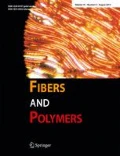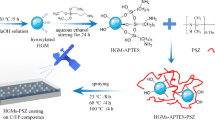Abstract
A low density material coating based on silicone polymer matrix reinforced with hollow glass microspheres is developed for thermal insulation. An organo-platinum compound is added to the resin matrix to make it a fast room temperature curing coating. It has a low density in the order of 0.39−0.34 g/cc with medium Shore A hardness in the order of 60–65. The thermal stability in an inert and oxidative environment was analyzed by the TGA method. The insulative properties are investigated using an infra-red heaters test set up, which showed almost 50 % temperature reduction on the substrate compared to the non-coated substrate. The coating properties, like adhesion, impact resistance, corrosion resistance, etc., are analyzed using various bond promoters and excellent in the class of insulative coatings. The effect of various diluents on the curing is observed and then finalized the suitable diluents for spray coating. The coating forms hard silica char, which in turn protect the surface from further high temperatures. A scheme for painting the metallic and non-metallic articles is also established for ease of application to the user.
Similar content being viewed by others
References
M. Natali, J. M. Kenny, and L. Torre, A Review, Prog. Mater. Sci., 84, 192 (2016).
U. Eduok, O. Faye, and J. Szpunar, Prog. Org. Coat., 111, 124 (2017).
D. K. S. Tarek, M. Fouad, E. F. Abadir, and S. M. El-Marsafy, Int. J. Eng. Res. Technol., 5, 428 (2016).
E. V. Titov, R. Kumar, and D. A. Levin, AIP Conf. Proc., 1333, 492 (2011).
M. Natali, I. Puri, J. Kenny, L. Torre, and M. Rallini, Polym. Degrad. Stab., 141, 84 (2017).
E. Venkatapathy, B. Laub, G. J. Hartman, J. O. Arnold, M. J. Wright, and G. A. Allen, Adv. Sp. Res., 44, 138 (2009).
B. Zhu, J. Ma, J. Wang, J. Wu, and D. Peng, J. Reinf. Plast. Compos., 31, 1311 (2012).
J. Li, X. Luo, and X. Lin, Mater. Des., 46, 902 (2013).
E. L. Strauss, US Patent, 4031059 A (1977).
J. W. Gooch (Ed.), “Ablative Plastic”, Encycl. Dict. Polym., Springer New York, New York, NY, 2011.
K.-S. Jang, Polym. Test., 84, 106408 (2020).
E. STRAUSS, Response of Superlight Ablators to Various Heat Pulses, in: 9th Struct. Dyn. Mater. Conf., 2012.
E. L. Strauss, J. Spacecr. Rockets, 5, 1357 (1968).
A. O. Barney, US Patent, US6627697B2 (2003).
T. Srivastava, N. K. Katari, B. R. Ravuri, and R. Gundla, Silicon, doi: https://doi.org/10.1007/s12633-020-00869-5 (2020).
W. Zhou, H. Yang, X. Guo, and J. Lu, Polym. Degrad. Stab., 91, 1471 (2006).
P. R. Dvornic in “Thermal Properties of Polysiloxanes” (R. G. Jones, W. Ando, and J. Chojnowski Eds.), Silicon-Containing Polym. Sci. Technol. Their Synth. Appl., pp.185–212, Springer Netherlands, Dordrecht, 2000.
G. Rajesh, P. K. Maji, M. Bhattacharya, A. Choudhury, N. Roy, A. Saxena, and A. K. Bhowmick, Polym. Polym. Compos., 18, 477 (2010).
C. Kan, Q. Yuan, A. Luo, and X. Kong, Polym. Adv. Technol., 7, 76 (1996).
P. Mazurek, S. Vudayagiri, and A. L. Skov, Chem. Soc. Rev., 48, 1448 (2019).
J. N. Lee, C. Park, and G. M. Whitesides, Anal. Chem., 75, 6544 (2003).
E. Favre, Eur. Polym. J., 32, 1183 (1996).
B. Arkles, Chemtech, 7, 766 (1977).
S. Hamdani, Devarennes, C. Longuet, D. Perrin, J.-M. Lopez-cuesta, and F. Ganachaud, Polym. Degrad. Stab., 94, 465 (2009).
B. Gardelle, S. Duquesne, P. Vandereecken, S. Bellayer, and S. Bourbigot, Prog. Org. Coat., 76, 1633 (2013).
J. Lentini, J. Forensic Sci., 37, 1358 (1992).
Acknowledgement
The authors are thankful to DRDO for support of this work. They are also thankful to Director, DRDL for all support and encouragement to carry out experimental works.
Author information
Authors and Affiliations
Corresponding authors
Supplementary Information
Rights and permissions
About this article
Cite this article
Srivastava, T., Katari, N.K., Krishna Mohan, S. et al. Studies on Hollow Glass Microsphere Reinforced Silicone Matrix Composite for Use in Fast Curing Low Density Thermal Insulation Coating Applications. Fibers Polym 23, 175–183 (2022). https://doi.org/10.1007/s12221-021-0566-0
Received:
Revised:
Accepted:
Published:
Issue Date:
DOI: https://doi.org/10.1007/s12221-021-0566-0




